Vipers are named for their tendency to give birth to live young. They’re a venomous family of snakes that live scattered throughout most of the world. Armed with hollow fangs for injecting their prey, they tend to ambush their victims. As a member of the Crotalinae subspecies of vipers, Rattlesnakes are a type of viper that use pit organs to detect the body heat of those nearby before ambushing them. Native to the Americas, rattlesnakes get their name from their unique rattle. Let’s take a look at viper vs. rattlesnake and see what sets rattlesnakes apart from other vipers.
Comparing Vipers and Rattlesnakes
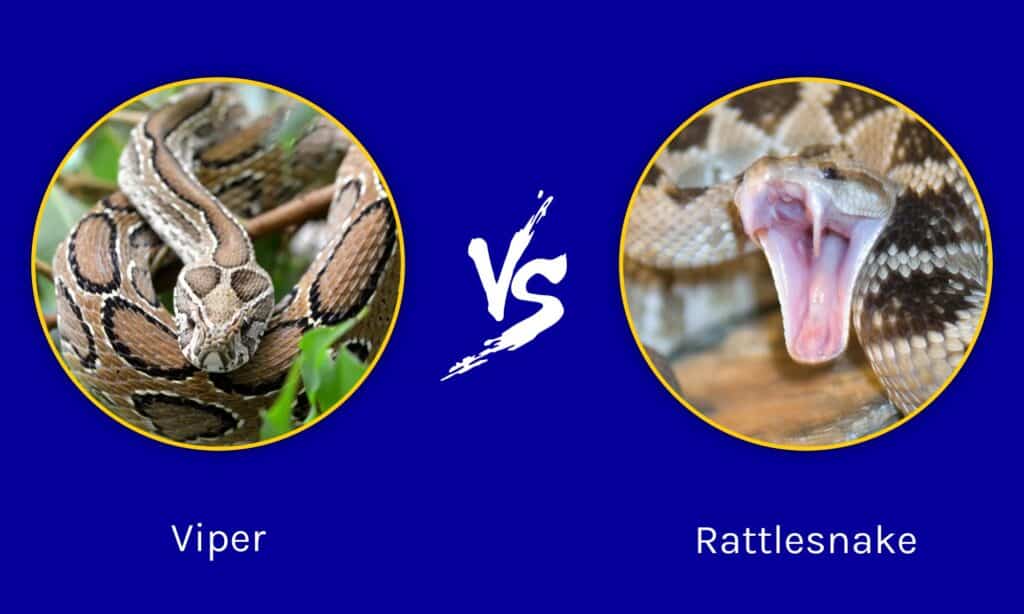
| Viper | Rattlesnake | |
|---|---|---|
| Scientific Classification | Family: Viperidae; Subfamilies: Azemiopinae, Causinae, Crotalinae, Viperinae | Family: Viperidae; Subfamily: Crotalinae; Genus: Crotalus or Sistrurus |
| Location | Cosmopolitan | The Americas |
| Size | 1/2 ft to 12 ft in length, up to 25 lbs | 1.5 to 8 ft in length, up to 10 lbs |
| Appearance | Triangular head, stocky body, short tail, hollow fangs, elliptical pupils | Distinctive tail rattle, geometric body patterning, triangular head, stocky body, short tail, hollow fangs, elliptical pupils |
| Reproduction | Mainly ovoviviparous, some oviparous | Ovoviviparous |
| Behavior | Ambush predators | Ambush predators, rattle tail to warn of strike |
| Venom | Some species are highly dangerous & deadly | Dangerous bites, rarely deadly if treated |
The Key Differences between Vipers and Rattlesnakes
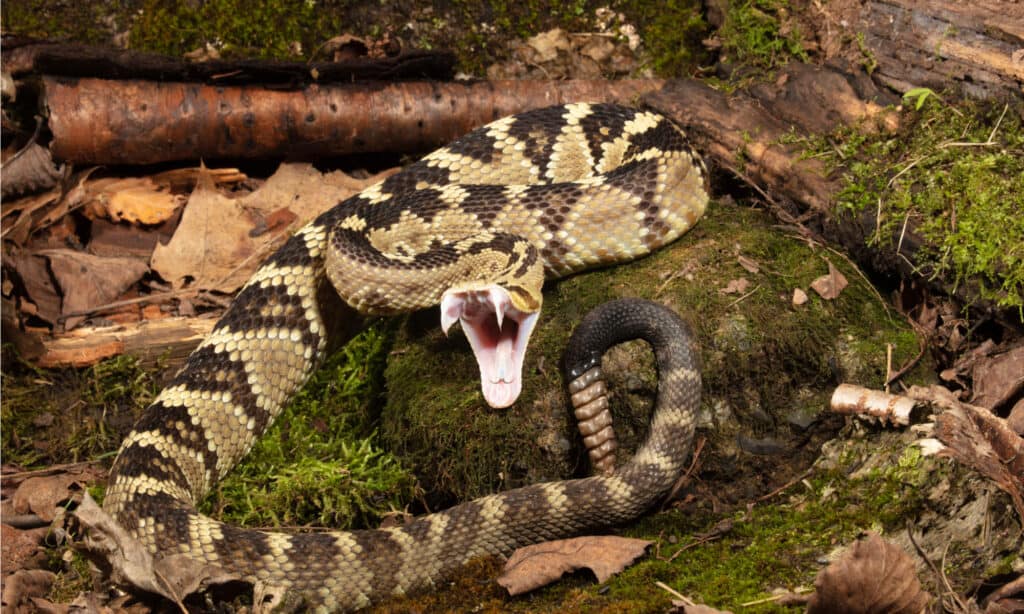
Rattlesnakes have a unique danger signaling.
©Joe McDonald/Shutterstock.com
The key differences between vipers and rattlesnakes are location, size, appearance, reproduction, behavior, and venom potency.
Viper vs Rattlesnake: Scientific Classification
Vipers are part of the family Viperidae, which includes over 300 different venomous species. They derive their family name Viperidae from the latin vivus, “alive” and parere, “to bear.” This refers to their method of bearing live young.
There are four subfamilies of vipers:
- Azemiopinae: This subfamily includes only two species and these tend to look very different from most vipers.
- Causinae: Known as the night adders, they’re endemic to sub-Saharan Africa. Notably, they’re oviparous, laying eggs in contrast to most vipers.
- Crotalinae: These are the pit vipers with heat-sensing organs called pits. Members include rattlesnakes, cottonmouths, and copperheads. Seventy percent of viper species fall within this subfamily.
- Viperinae: Members of this subfamily are known as true vipers. Puff adders, common European adders, and bush vipers are part of this subfamily.
Rattlesnakes are fanged pit vipers of the family Viperidae. As pit vipers, they belong to the subfamily Crotalinae. There are over 30 rattlesnake species and most fall into the genus of Crotalus. This genus name is derived from the word for “castanet.” A couple of species are in the genus Sistrurus, meaning “tail rattler.” This name shares its root with the sistrum, a type of rattle that is an ancient Egyptian musical instrument.
Viper vs Rattlesnake: Habitat & Range
Vipers are considered a cosmopolitan family of snakes, as they enjoy widespread distribution, living in most parts of the world. There are few places where you can’t find vipers. These include Antarctica, Australia, Hawaii, Madagascar, and several other isolated locations. As a diverse family of many species, vipers enjoy a range of habitats. They live in woodlands, scrubs, forests, rocky areas, and deserts. You can find them on the coasts, in wetlands and swamps, rainforests, mountainous zones, and more.
Rattlesnakes are native to the Americas, from southern Canada to Argentina. The highest concentration of rattlesnakes lives in the southwestern United States and northern parts of Mexico. Many rattlesnakes live in the dry desert climate of the southwest United States but can thrive elsewhere. These snakes do well in grassy areas, rocky hills, swamplands, meadows, and brushy areas. Rattlesnakes make their home within rocky crevices. They live communally in these dens and take a period of rest in them during the cold winter months, called brumation.
Viper Vs Rattlesnake: Size
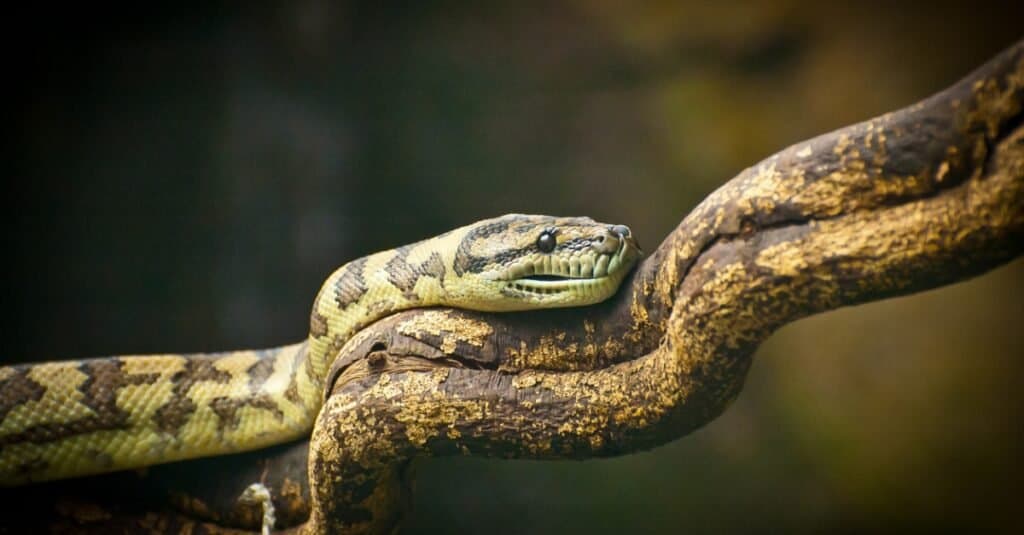
The bushmaster snake ranges in size from 6 to 12 feet.
©iStock.com/madov
Vipers vary greatly in size depending on the species, with some incredibly small and others impressively large. For example, the Namaqua dwarf adder (Bitis schneideri) may be the smallest of all vipers. This species has an average length from head to tail of 7 to 10 inches, growing to 11 inches at the very most. In fact, the bushmaster can grow to even longer lengths than the eastern diamondback rattlesnake, making them the longest pit viper in the world. They often reach lengths of at least 6 feet but can be 12 feet or more in length. The gaboon viper is a very heavy species, reaching 20 to 25 pounds. Also varying by species, rattlesnakes are generally 1.5 to 6.5 feet in length. Some, like the eastern diamondback, can grow up to 8 feet in length and weigh up to 10 pounds.
Viper Vs Rattlesnake: Appearance
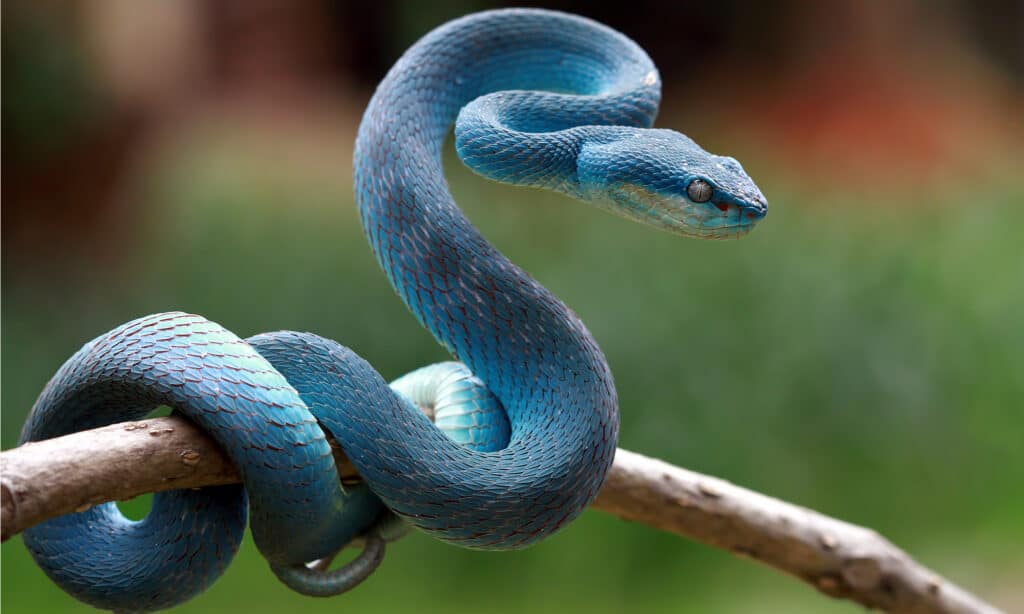
Viper species, such as this stunning Blue viper snake, can vary greatly in appearance.
©Kurit afshen/Shutterstock.com
Vipers display a fantastic range of patterns and coloration. All vipers are characterized by solenoglyphous fangs that are hollow to inject venom from glands behind their eyes. These fangs fold up to the roof of the mouth when they aren’t in use. Most vipers have heavily-ridged, “keeled” scales. They typically have a triangular-shaped head, a stocky body, and a short tail. The vast majority have vertical, cat-like pupils that can expand to fill the eye or contract fully, allowing acute vision in a range of light settings.
Like other vipers, rattlesnakes have a triangular head, hinged fangs, and thick bodies with keeled scales. Their coloration varies, but they typically have dark diamond patterns or other geometric shapes on a lighter-colored body. They’re set apart from other vipers by their distinctive tail rattles. These are made of hollow keratin chambers that knock together to produce sound. Rattlesnakes have pit organs beside their nose and eyes to detect the heat signatures of animals nearby, like an infrared camera.
Viper Vs Rattlesnake: Reproduction
As their family name suggests, most species are ovoviviparous, incubating eggs inside the mother’s body and then giving birth to live young. However, some like those of the Causinae subfamily are oviparous, laying eggs instead. All rattlesnake species are ovoviviparous, giving birth to live young.
Viper Vs Rattlesnake: Behavior
Most vipers are skilled ambush predators. This means they hunt by waiting patiently for unsuspecting prey to approach. When threatened, some may vibrate their tails in warning. Vipers live solitary lives, mostly interacting during the breeding season. However, some species will brumate during the winter months with large groups in communal dens.
Rattlesnakes’ tail rattles afford them a unique trait not shared with other vipers. When threatened, they shake their tails to produce a maraca-like warning sound, letting the target know that a strike is imminent. While other vipers like copperheads, cottonmouths, and bush vipers may produce a buzzing sound when their tail rattles against something, rattlesnakes produce a true rattle. Rattlesnakes are generally solitary unless in brumation or breeding.
Viper Vs Rattlesnake: Venom & Danger
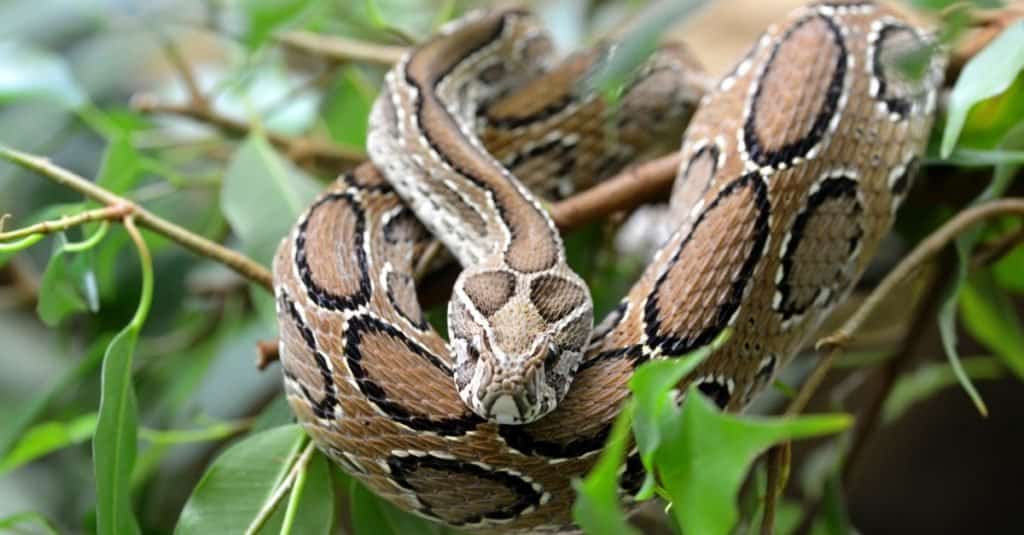
The Russell’s viper is one of the world’s deadliest snakes.
©jaroslava V/Shutterstock.com
Like all other characteristics, viper venom varies by species, but these snakes represent some of the world’s deadliest snakes. Some, like Russell’s viper, are aggressive and bite without provocation. They produce painful bites with a high fatality rate. These snakes cause 15,000 to 25,000 deaths per year in India. The saw-scaled viper is also aggressive and considered to be one of the world’s most deadly snakes.
The long fangs of the timber rattlesnake deliver venom that’s potent enough to kill a human. A defining characteristic of the timber rattlesnake is crotoxin, or “canebrake toxin.” This is a potent neurotoxin that can lead to paralysis. All rattlesnake bites should be treated as medical emergencies as the hemotoxin in their venom kills red blood cells and leads to tissue damage. Antivenom is widely available, and human deaths are rare as long as treatment is delivered.
The photo featured at the top of this post is © Ali Bernie Buga-ay/Shutterstock.com
Discover the "Monster" Snake 5X Bigger than an Anaconda
Every day A-Z Animals sends out some of the most incredible facts in the world from our free newsletter. Want to discover the 10 most beautiful snakes in the world, a "snake island" where you're never more than 3 feet from danger, or a "monster" snake 5X larger than an anaconda? Then sign up right now and you'll start receiving our daily newsletter absolutely free.
Thank you for reading! Have some feedback for us? Contact the AZ Animals editorial team.






